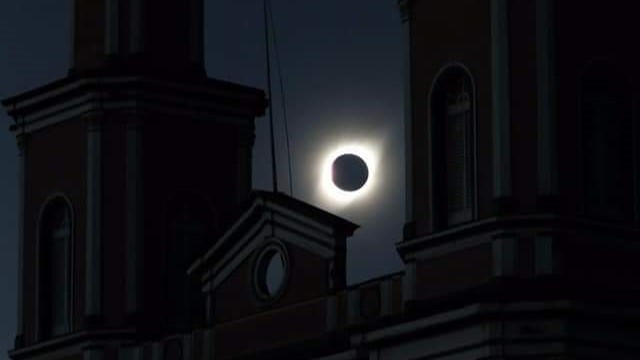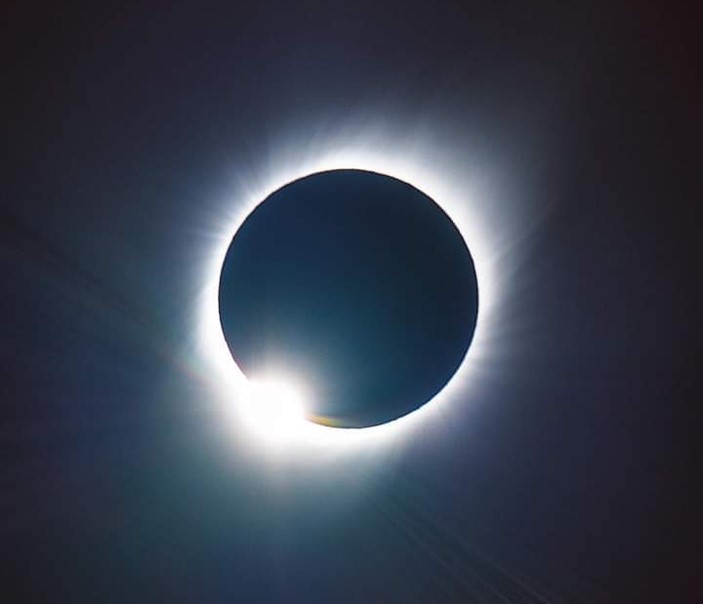Stars and STEM Stories
Eclipses in the Skies of Chile
In the proximity of the next visible solar eclipse in the northern hemisphere that will coincide in time and place with the 2023 Latin America and Caribbean (LAC) Regional Meeting, the GLOBE Chile team participated in a previous eclipse-related phenomenon.

On 2 July 2019 around 4:30 p.m. local time, a team in Santiago, Chile followed the NASA transmission from Cerro Tololo along with students gathered in the main hall of the University of the Americas. Other teams joined in as well, including: a team located in Coquimbo (groups in the interior of La Serena -- Vicuña and Cochiguaz) organized by Verónica Espinoza of Federico Lohse de los Vilos high school; teams from the national coordination and AIEP institute (Prof. Sergio Pérez) in Bahia from Punta Choros on the coast and inland to the south in the Combarbalá area. Professors Manuel Banchiere and Víctor del Fierro (Colonel Eleuterio Ramírez Molina high school), captured images, temperatures and anecdotal records of the astronomical event -- an eclipse.
Banchiere's camera and professional equipment caught images and video. The teams located in Punta choros were able to capture erratic behaviors of the local animals at the time of the eclipse, like: an unusual approach of chilla foxes, herds of llamas, among other species moving among people when normally they stay away; an atypical grouping of Humboldt penguins; and different movements of dolphins in the sea. According to the renowned UMCE ethologist Marcial Beltrami, Ph.D., the atypical suppression of luminosity always produces reactive effects in living beings that are usually captured proportionally to the time of occurrences such as eclipses. Beltrami has observed baboon monkeys at the Santiago de Chile Zoo in previous eclipses and other experiences that are reflected in his scientific work.
The teams and students met again on, 14 December 2020 around 1:00 p.m., for another similar event in southern Chile, with mobility restrictions due to the pandemic and in very different and adverse weather conditions. There was cloudiness and eventual rain, as anticipated by associate meteorologist Roberto Rondanelli, Ph.D, in his talk at the LAC webinar prior to the event. The strategy was to place teams of observers between Villarrica and Pucón and the Pitrufquén area (NASA transmitted from the Villarica volcano) and a mobile van for the instruments and advisers of Biancheri, who, in his journey, managed to locate an opening space in the sky in Lau Lau Hill, Lastarria, Gorbea and achieved one of the best-known civil registries. In Pitrufquen, the team led by Pablo Godoy made more ethological observations in domestic and farm animals that, at the moment of darkness, went to take shelter in places where they sleep; it is worth mentioning that this day was particularly dark. Additionally, in bibliographic reviews, students found similar situations of some tarantulas in Africa and multiple descriptions of other animal reactions.

Raúl Pérez Orellana says, "As a GLOBE Country Coordinator and environmental educator, I am satisfied with the results of the campaigns that involved their respective educational communities and social environments in a concept of citizen science and contributed to the scientific literacy process of many groups in the GLOBE objectives."
In the investigative field of the GLOBE atmosphere sphere, people must consider that eclipses can have notable effects on the environment. During a solar eclipse, the decrease in sunlight affects the temperature and luminosity (brightness). There may also be changes in wind direction and atmospheric humidity. These effects, such as the manifestations of the solar corona, are inputs for scientific studies and analysis to produce knowledge about the interaction between eclipses, their effects and the Earth's atmosphere. It is worth noting that, during a 1919 solar eclipse, observations were made that confirmed Einstein's prediction about the deflection of light due to the gravity of the Sun. This experimental confirmation was an important milestone in the validation of the Theory of General Relativity, according to which gravity is not only an attractive force between massive objects, but also manifests itself as a curvature in space-time caused by the presence of mass and energy.
Images courtesy Raúl Pérez Orellana, GLOBE Chile Country Coordinator.





